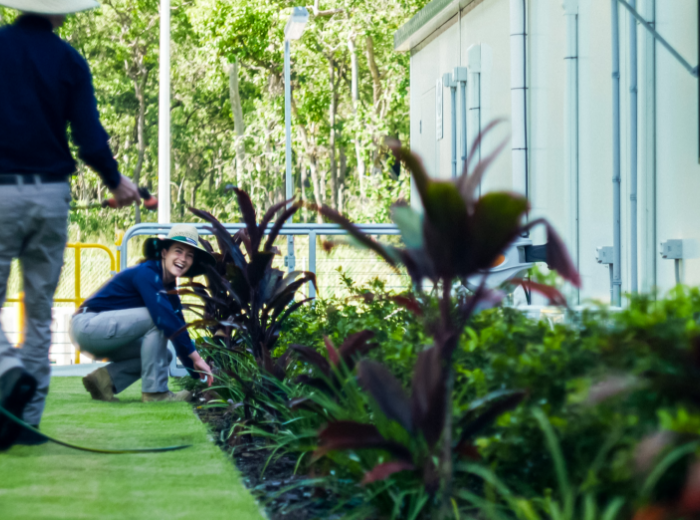Lithium ion batteries make portable power possible. Ubiquitous in our homes and offices, they are now even starting to replace internal combustion engines on the road. Used due to their leading capacity, efficiency, versatility and safety, lithium ion batteries will become a $91 billion dollar (USD) global industry by 2030. Without aluminium, the power of lithium ion batteries would not be possible. With a manufacturing base in Australia, Alpha HPA is committed to producing the highest quality aluminium products available for the production of lithium ion batteries.
How Do Lithium Ion Batteries Work?
Lithium ion batteries are made with layers of metal compounds that facilitate a chemical reaction. There are four main components within every battery; a cathode, anode, separator and electrolyte layer. Power is produced when ions pass through the electrolyte layer from anode to cathode. The electrolyte filters out electrons, causing them to be routed through the circuit on the way to the cathode. Once a power supply is connected to the battery, electrons return to the anode. This then attracts positively charged lithium ions to pass back through the electrolyte and become temporarily stored in the anode until the device is turned on.
What’s Inside A Lithium Ion Battery?
The materials inside a lithium-ion battery can vary slightly for each component. New compounds are being studied for their potential to increase energy density, particularly in the cathode. Lithium ion batteries in Australia are comprised of:
- Lithium
Lithium is used for its tendency to give up its electron, making it a highly reactive metal in its pure form.
- Cathode
To stabilise lithium ions, batteries contain a metal oxide in the cathode that is coated onto an aluminium sheet.
- Graphite
To temporarily store lithium and electrons, graphite is coated onto a copper sheet in the anode.
- Electrolyte
The layer that exclusively allows for ions to pass through is made of salts, solvents and other additives.
- HPA Coated Separator
The layer that separates the anode from the cathode to prevent instability and ensure safety is made of synthetic resins such as polyethylene and polypropylene.
Why Do Batteries Need Aluminium?
Aluminium sulfate is found in the positive terminal of batteries, also known as the cathode. Within the cathode, a metal oxide such as cobalt peroxide is used to collect positively charged lithium ions. This cobalt is not efficient at collecting and distributing lithium ions by itself, so it is coated onto conductive sheets of aluminium. The aluminium acts as a current collector and allows positive tabs to be used for charging. The metal oxide coated aluminium becomes one of three sheets that are wound onto a central core to form a cylinder as seen in electric vehicles, or folded in on itself to fit into mobile phones. Our >99.999% (5N) aluminium sulfate is the purest product available at commercial scale for the synthesis of active cathode materials.
High purity alumina (HPA) is an essential safety material also used in lithium ion batteries. One of HPA’s fastest growing applications is coating separators for safe, long-lasting and thermally protected batteries. As commercial manufacturers ramp up production capacity to compete in energy storage, next-gen consumer electronics and automotive applications, this demand is forecasted to grow dramatically.
The Advantage of Lithium Ion Batteries
Lithium ion batteries have many advantages that have made them commonplace in Australia today. They possess a high energy density compared to their weight, making them ideal for use in portable devices and vehicles. They have faster charging speeds than traditional lead-acid batteries which is important for convenience. Batteries do not last forever, as each charging cycle diminishes the efficiency of the battery until it eventually dies. Lithium ion has a much longer lifespan compared to lead-acid, typically lasting 300 to 500 charge cycles before degrading completely. In vehicles, the Tesla Model 3’s lithium ion batteries can survive more than 1,500 charge cycles. Improving upon all these advantages and expanding the battery life cycle is an ongoing challenge for manufacturers.
The Future of Batteries in Australia
Research and development for batteries is increasing worldwide to achieve new levels of battery performance. In the future, the storage medium currently made from graphite could be replaced with silicon which if successful could significantly increase energy capacity. Research from the University of Queensland has opened up new possibilities for commercial batteries. Replacing lithium with aluminium has been demonstrated to increase charging speeds to be 60 times as fast. Graphene Manufacturing Group is currently developing the cells, hoping to eventually replace lithium ion batteries in small electronics, energy storage solutions and electric vehicles in Australia.
Want to Learn More About The Role of Aluminium in Lithium Ion Batteries?
The driving market forces behind lithium ion batteries in Australia have sparked unprecedented interest in the production of HPA and pure aluminium sulfate. You can learn more about our high purity alumina products, manufacturing and commercial availability by contacting our team at Alpha HPA. Visit our investor centre to learn about the development of our products and commitment to building a sustainable future.



